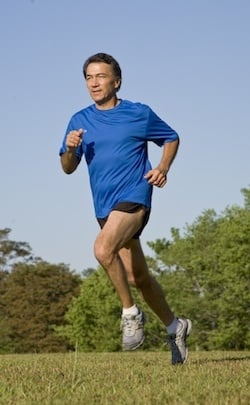
Danny Dreyer might have found the answer to the age-old question, “How can I make running enjoyable?” The solution: Don’t use your legs.
There’s more to it than that, of course, but the claim—plus curiosity and a bit of doubt—was what brought me to Dreyer’s Chi Running workshop last Saturday in Chevy Chase. I was a sprinter and jumper for ten years, but long-distance running and I just never really clicked. Ask me to choose between a 20-minute run and 100 squats, and I’d choose the latter.
I had spent the last month reading about Dreyer’s running technique, which is a blend of T’ai Chi principles that allow for efficient, painless running. Dreyer, an ultra-marathon runner, was inspired to change the way he ran after taking a class with T’ai Chi master Zhu Xilin.
“My instructor told me how alignment really works to support your body weight,” Dreyer says. “In T’ai Chi, all the movement comes from your center, so I started playing with this concept and applying it to running. It totally rocked my boat.”
Chi Running relies on two things to transfer our “chi,” or energy, elsewhere: body alignment and relaxation. A person’s alignment, posture, and lower core—not the legs—should do all the work. So this was a chance to learn how to run without waking up to wobbly legs the next day. And no shin splints, to boot? It all sounded to good to be true.
That Saturday at 9 AM, I walked into a banquet room filled with about 30 people, who were all dressed in running gear—and all older than me. At one point during the day, a woman said she admired me for getting a head start on correcting my run. “What are you, 12?” she asked. I’m 23.
By a show of hands, I was relieved when I saw only one ultra-marathon runner in the room besides Dreyer; the rest of us were a mix of marathon, recreational, and novice runners.
“Today you won’t master Chi Running,” Dreyer told us up front. “This is just the beginning.”
If any of us were expecting to get in a long run during this workshop or learn T’ai Chi, we were mistaken. “You don’t need to know anything about T’ai Chi,” Dreyer says. “You learn how to engage your center and how to relax your arms and legs, but it’s all put into running verbiage.”
For the next seven and a half hours, we did drill after drill, learning the fundamentals of Chi Running. First up was the easy stuff: mastering good posture, which is crucial to building strong core muscles. Dreyer had us sit upright in our chairs, then practice standing with our feet hip-width apart and parallel while maintaining the same upright posture.
“I know I’ve run correctly when my abs are sore the day after a race,” Dreyer says.
But things got more complicated after that. I struggled once we moved onto techniques such as the mid-foot strike, in which your whole foot lands evenly balanced instead of putting the brunt of pressure on your heel. As a high jumper, I did countless jumping drills that emphasized the rolling-contact technique which does the very opposite: landing on the heel and rolling the foot toward the toe to push one’s body forward. I imagined my coach screaming, “Have I taught you nothing?”
Then there was the issue of leaning, or what Dreyer calls the “gas pedal.” Instead of relying on your legs, you should run with a slight lean and let gravity do the work of moving you forwards. To increase speed, you should increase your lean—the same way a gas pedal works. To slow down, lean less.
“Propulsion comes from the fact that you’re falling forward,” Dreyer explained. “When you come down on your foot, that’s just a momentary support.”
Once 4:30 rolled around, I had run probably less than a mile. But my mind was exhausted after cramming it with this information: Stand with toes pointed forward and feet hip-width apart; slightly bend your knees; engage your core; lean forward; keep your chin down and shoulders back; and bend your arms at a 90-degree angle. Somehow between all that, I was supposed to remember to breathe.
I may not have had an “Aha!” moment during the workshop, but if I took anything from Dreyer that day, it was this: run like a kid. Kids have the perfect running form: a great lean, open strides with the heels kicked back, and relaxed arms. They can run around for hours and never break a sweat. Kids are lucky—they enjoy running without even realizing it.
“At some point you’ll be running around and something will open up,” Dreyer assured us. “You’ll say, ‘Oh my god. Who ever said this was about running?’ ”
Subscribe to Washingtonian
Follow Well+Being on Twitter
More >> Health | Top Doctors | Well+Being Blog










